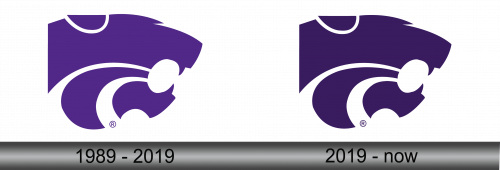Kansas State Wildcats Logo
The Kansas State Wildcats represent Kansas State University in NCAA Division I athletics. Known for their distinctive purple and white colors, the Wildcats excel in various sports, most notably football, basketball, and baseball. The football team, a Big 12 Conference member, often plays at Bill Snyder Family Stadium, named after a legendary coach. The men’s basketball team, with a rich history, competes at Bramlage Coliseum, nicknamed “The Octagon of Doom.” The Wildcats embody a competitive spirit and strong community support, symbolizing the pride of K-State in Manhattan, Kansas.
Meaning and history
The Kansas State Wildcats, representing Kansas State University, have a storied history in collegiate athletics, blending triumphs and challenges. This legacy is woven into the fabric of Manhattan, Kansas, where the university is located.
Football has been a central part of this legacy. The Wildcats, once underdogs in the collegiate football scene, underwent a dramatic transformation under the leadership of Coach Bill Snyder. Starting in 1989, Snyder steered the team from obscurity to prominence, earning the Wildcats several conference championships and regular bowl game appearances. This remarkable turnaround is a testament to resilience and determination, culminating in the football stadium being named in Snyder’s honor.
The men’s basketball team, tracing its roots to the early 20th century, has been a powerhouse in the NCAA, making significant tournament runs and even reaching the Final Four. The women’s basketball team, though younger, mirrors this success, highlighting K-State’s dedication to fostering competitive teams in both genders.
K-State’s athletic prowess extends beyond football and basketball. The baseball team, along with other sports like track and field, volleyball, and soccer, has also seen moments of brilliance, contributing to the Wildcats’ esteemed reputation in collegiate sports. These achievements across various disciplines underscore the university’s commitment to excellence in athletics.
The Wildcats’ narrative is enriched by the athletes who have gone on to professional success, showcasing K-State’s role in nurturing sporting talent. More than a tale of victories, the Kansas State Wildcats’ history is a mosaic of perseverance, community engagement, and a spirited competitiveness that echoes across the campus and among its supporters.
What is Kansas State Wildcats?
The Kansas State Wildcats are the athletic teams representing Kansas State University in NCAA Division I sports competitions. Known for their distinctive purple and white colors, they compete in various sports including football, basketball, and baseball, showcasing a legacy of competitive spirit and athletic excellence. The Wildcats, deeply embedded in the culture of Manhattan, Kansas, have a rich history of achievements and community pride.
1989 – 2019
This logo features a stylized wildcat head, composed of bold, sweeping curves that suggest both movement and strength. The design is minimalist, utilizing just two colors: a deep royal purple that dominates, and white that outlines and highlights, giving the image a crisp, clear contrast. The cat’s silhouette is abstract, yet unmistakably feline, with a pointed ear to the top right and a forward-jutting cheek to the left, evoking the alertness and agility of a wildcat. The eye, though not detailed, is implied through the white space, lending the image a sense of life and intensity. The overall effect is modern and dynamic, embodying the fierce spirit of the Kansas State Wildcats.
2019 – Today
The emblem maintains its original, dynamic silhouette of a wildcat, yet there’s a notable shift in its color palette. Where once the purple hue was vivid and deep, it now takes on a darker, more muted tone, altering the logo’s visual impact. This subtler shade of purple conveys a sense of evolution while preserving the team’s identity. The white elements remain unchanged, continuing to define and accentuate the wildcat’s features with clarity. This color adjustment reflects a modernized approach, aligning the Wildcats’ visual representation with contemporary design trends.













